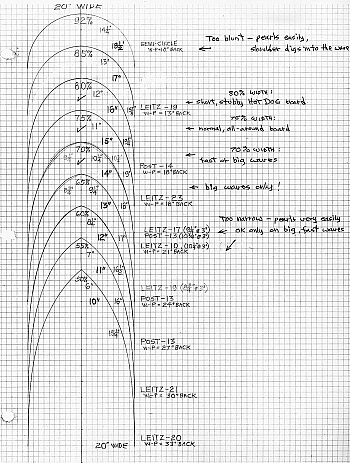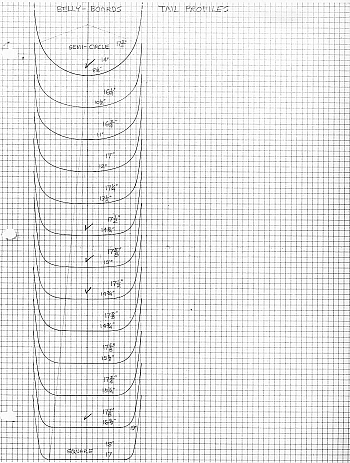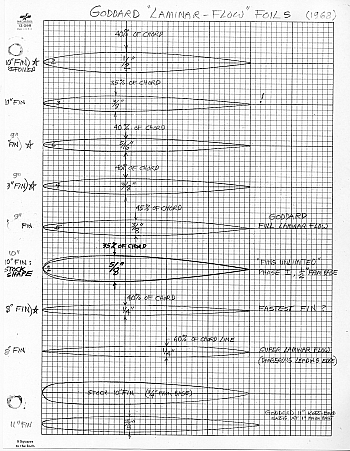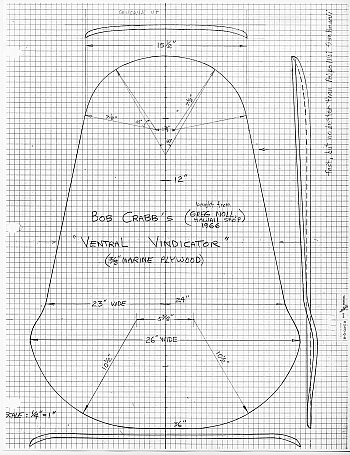October 6, 2009 - Waikiki
Beach,
Honolulu, Hawaii
Interview
by John Clark based on questions
from Bob Green
Appendix based on e-mails with Bob Green between Sept. 2009 - Nov. 2009
Additional text and figures added based on subsequent e-mails
(Note: ##-Name refers to the file names in the
design sheets.)
Harry Akisada R.I.P.
1. Larry, did you start surfing on a
stand-up board? What got you started on a Paipo Nui board? When was
this?
I
was born on April 26, 1935. I’m 74 now. I was born and raised in Los
Angeles until I was 11. Then my family moved to Inglewood, California.
I ran cross country, raced bicycles, and was an AAU swimmer in high
school. I was a bodysurfer first. I started bodysurfing in the summer
of 1947 at Hermosa Beach, when I was 12 years old. I started surfing on
a surfboard in 1950 at Manhattan Beach, while I was still in high
school. I surfed summers and graduated in 1953. I went in the Army from
1958-61, spending two years in Germany.
|
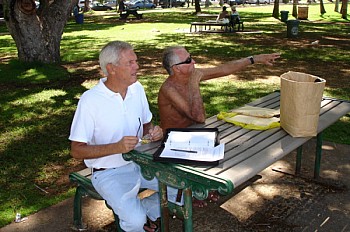
John Clark and Larry Goddard at Waikiki
Photo
by: Bud Scelsa
|
When I got out of the Army in 1961, the beach
was super crowded because
of the movie Gidget. There were lots of hodads - inland, non-surfers
who
came to the beach. I went down to Redondo Beach one warm day in
December, 1963, in front of the lifeguard headquarters,
and watched
glassy 6-8 ft waves breaking next to the sea
wall. There were only a
handful of surfers out. A guy and his girlfriend
were there near me
taking turns sand-sliding on a round plywood sand-sliding board. When
they took a break and came near me to lay down in the sun, I asked them
if I could borrow it and see if I could ride a wave with it. I went out
to the lineup and got a couple of skidding rides.
Paul
Mathies, the head lifeguard at the time, was in the lineup and saw me
trying to ride the waves with the sand-slide board. I told him I was
looking for something faster than a surfboard. Paul told me had just
the thing I was looking for. So, we got out of the water and I followed
him to the lifeguard storeroom. He brought out a Wally Froiseth balsa
twin-fin bellyboard, made for the Makaha surf. It was the first one I’d
ever seen. That was the beginning of my paipo/bellyboard surfing
experience.
Several months later a surf movie at Hermosa
Beach’s Pier Avenue School
showed Greg Noll and John Waidelich at Waimea Bay in 20 ft surf. John
took off late on one wave well behind Greg Noll, free fell about eight
feet, skipped like a flat stone, and skipped three more times, finally
went flying past a startled Greg Noll.
The next day after the surf movie was a
Saturday, so I went to Greg
Noll’s surf shop on Pacific Coast Highway and Pier Avenue in Hermosa.
When he opened the shop at 10 AM, I told him about the movie and asked
him about that ‘Paipo board’ that John Waidelich was riding that day.
Greg said he had three Val Valentine-made Paipo Nui’s, designed by
Waidelich. They were the only ones in California. So, I bought one. I
rode it from Point Dume to Baja, well past Ensenada. Those were some of
the most exciting days of my life, exploring all those spots. I could
ride in front of rocky cliffs or beaches where no surfers would venture.
The
plywood paipo was nice. It was easy to dive under waves, but I
wanted something with more flotation and more easily controlled, i.e.,
with skegs. I asked a local surfboard shaper to make me a board, but it
didn’t work. He made it too thin in the tail, and too thick in the
nose. Obviously, he knew absolutely nothing about bellyboards.
2.
When you started getting fiberglass boards made around 1965 was it
difficult getting a shaper to make a bellyboard? Were you riding custom
or stock paipo?
I
made some sketches of a board shape that I thought would be long enough
to maybe knee ride as well as belly ride. I showed the sketches to
Floyd Smith one day when he was visiting the Hermosa shop, and he made
one for me. It was almost 57 inches long by 20 ½” wide. It was fast but
proved to be a little too long for belly riding, and too short for knee
riding. I rode 10 ft. Malibu with it that summer of 1965.
Before the year was over, I had three more surfboard shapers make
boards for me, but none of them were quite right. Finally, in
desperation, I got a blank from Dewey Weber and shaped two bellyboards
from it, one 48” by 22”, double concave with a V-bottom, 7” single fin,
but made the nose wider than the tail. Then I realized that speed came
from a wide planing area and consequent lift in the tail where the
rider’s weight is concentrated. I started making boards for friends,
and I tried different lengths and widths.
Several of the surf shops started selling paipo boards. Bing Copeland
made some of the better ones. Most of those early boards didn’t really
work well. They were too thin or the tail was too narrow, or the
outline shape was too elliptical. You couldn’t get enough speed. I was
riding the Newport Wedge then with my Paipo Nui, but I wanted something
as fast, only easier to paddle. That meant a foam and fiberglass board,
with enough buoyancy to minimize bogging down on thicker, slower waves.
Surfboards in those early days of the ‘60s were just moving platforms
or ‘stages’ where you assumed all these graceful, but non-functional
poses. A good surfer was smooth and graceful. But the board went in a
straight line most of the time.
All my boards are foam and fiberglass construction. I make the
full-size templates myself, scaled up from the 1/8th-scale drawings,
and I do all the shaping. Never could get any surfboard shaper to do it
the way I WANTED. But the glass job is by a professional glasser. Over
the years, the hardest part was getting the sander to do the rails
exactly the way I specified. They can ruin the critical rail profile
you so carefully shaped if they don't follow your instructions
precisely.
3.
I believe you surfed Rincon with George Greenough. Did he influence
your ideas regarding board design or wave riding?
In
1965, I saw George Greenough for the first time at Rincon Point. He
rode a 5’ spoon, a kneeboard. He made it and put a single fin on it. He
copied the fin shape from a bluefin tuna. His boards were really fast,
and he even did El Rollos, barrel rolls, on them. In 1965 I talked to
George while he was waiting on the beach. He said there were millions
of years of ‘research and development’ in that fin design, and we had a
good laugh, because surfboards had such ugly, poorly designed skegs,
while the perfect solution was right there in plain sight on the
fastest swimming fish and dolphins, porpoises, and sharks! George was
already an excellent surf forecaster. On a big day at Rincon, he would
wait for the 40-minute sets way behind the point, catching the bigger
sets that would pass by well outside of the surfers in the main lineup
at the point. That’s a 600 yard ride!
The outline of my board matched the outline of George’s board. He had
studied hydrodynamics, so I started studying it, too. I got really
interested in designing. I did my own flow tests, getting towed behind
a friend’s ski boat. I tried different fin sizes, then twin fins. I
even came up with adjustable twin fins, but finally decided to go with
glass-in fins for maximum speed. I realized that single fins worked
best on really big waves. Less drag than twin fins.
Surfers then were still using big fat fins. I told Dewey Weber and the
other guys who had surf shops
about Greenough’s bluefin tuna fin shape and fin designs, and my own
fin designs followed it from there.
4.
Why did you move to Hawaii in 1969/1970? What was the paipo scene like
at the time? What was the approach to riding paipo and who were the
standouts at the time?
A
local guy told me that I should go to Hawaii where there were big waves
and “you can surf every day”. I was working for Air Research, an
aerospace company. I left in the summer of 1969. I brought 14 boards
over to Hawaii on September 29, 1969. I sold everything and came over
with $8000 and just surfed my brains out, testing and refining board
designs, mostly at Makaha.
5.
What is your approach to riding a big wave? Any particular rides stand
out from all the others?
In
the 1960s, I learned about timing waves, timing sets, and watching the
tides. I was able to predict where waves would come and when. It’s all
power of observation. My first practical education in Hawaii was
watching the ocean. I put it together with weather maps and got into
surf forecasting. No one did it then on TV or in the newspapers. You
just had to ‘read’ the signs and do your twice-daily surf checks.
The longest ride I ever had in my life was at Maili Point. It was about
an 18’ wave and I went for about ¾ of a mile. I lived at Makaha Shores,
and Makaha and Maili Point were my testing grounds for my boards.
I rode Yokohama, too. My friends brought me to Waikiki, and I rode out
at Portlock and Sandy Beach.
Larry recalls the challenges of a memorable wave, shown below, at the Makaha Bowl,
"Yeah,
I WAS airborne for a moment, because the lip of the wave in the Bowl
pitches out suddenly when the wave hits that shallow spot. This was an
easy passage across the infamous Makaha Bowl because it was a very WEST
swell, and there is little refraction on that swell direction. It gets
much dicier when the swell gets more Northwest. Then, the Bowl will
'Slam the Door' in your face most times. It is a crap shoot whether
'Shooting the Bowl' will be successful or not. You take your chances...
."
Larry Goddard riding high at the Makaha Bowl, November 1969.
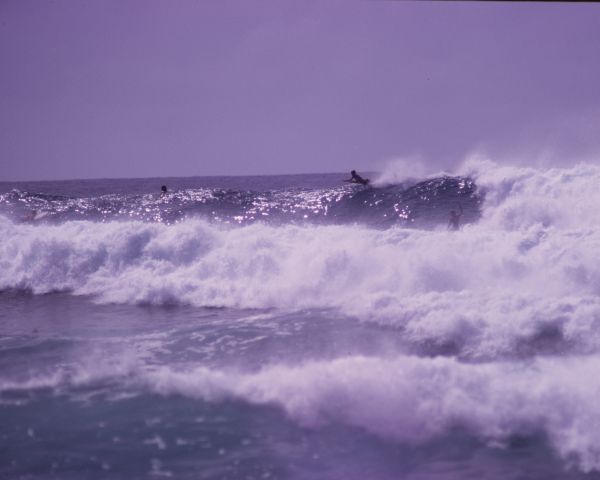
Photograph
courtesy of Larry Goddard. Photo by: Doc' White's wife. Larry relates
that Dr. Marshall White was a cancer doctor at the Veterans Hospital
(the famous pink Tripler Hospital), and he was a big-wave surfer when
he was free. His wife was on the beach with his camera on a tripod, and
was 'supposed' to be taking pictures of HIM. Ha! All I have is a 4 x
6-inch print. She didn't have a long telephoto lens, tho'. Oh
well...
6. Over the last 40 or so years you would have seen lots of waves, surfers
and fads. Who has stood out for you, either as a paipo builder or rider?
Greenough
tried to convince California surfers to ride smaller boards, so they
could manoeuvre more quickly, but they weren’t interested, because you
can’t ‘hang ten’ on a short board. He went to Australia and got
Bob McTavish interested. Nat Young rode an 8’6” McTavish v-bottom
tail board to victory in 1966 at the World Surfing Championships in San
Diego. That marked the end of the long board era, and was the beginning
of the high-performance short board revolution.
The paipo riders that impress me the most are Harry Akisada and one of
his friends, a younger guy named Mike Aisaka who’s Harry’s protégé. The
fastest, most advanced plywood skegless paipo boards are made by Harry
Akisada, two-time Makapu’u Paipo Champion. He has a custom-made mold
that puts a double concave in the bottom. He has a beautiful complex
concave on the bottom. He’s really good. Harry’s amazing to watch at
Makaha. He’s the master of trim on big waves. On his board he can pull
off high performance manoeuvres. Guys that ride paipos exclusively just
like going fast. I knew Paul Swanson in the early '70s when he and my
friend Steve Gendel were tearing up the waves at Pupukea on the North
Shore.
The genius of Tom Morey’s bodyboard design is the “upside down” rail
that gives the rider some edge control on a wave.
7. [Update: 2017 and 2018] Larry recently came across some of his old photographs and was so stoked he wanted to share them.
Makaha
was a favorite surfriding and photo shooting locale of Larry Goddard's.
And Buzzy Trent was admired as a surfer and a person. Larry misplaced
some of his records or notes of film that he shot during Hurricane
"IWA" ('ee-vah', Frigate Bird) in November, 1982, so he can't say
exactly when it was shot. Some day he will dig out his surf notes and
reports to try matching up the most likely date of the photo.
Buzzy Trent in the slot at Makaha at sundown, ca. Feb. 1973.
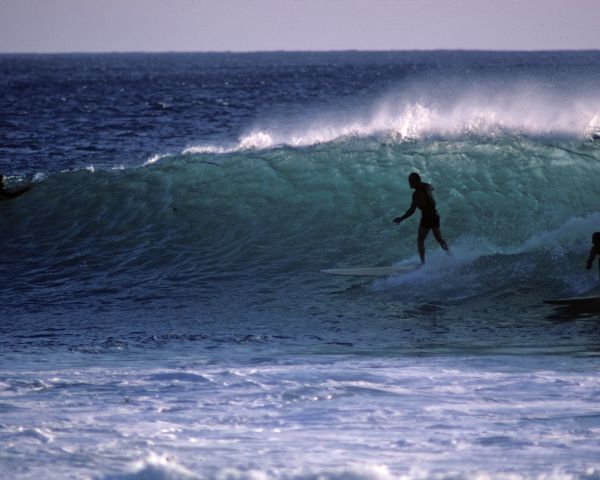
Photograph by Larry Goddard.
Not for commercial use.
Unknown charging the curl at Makaha, ca. December 1974.
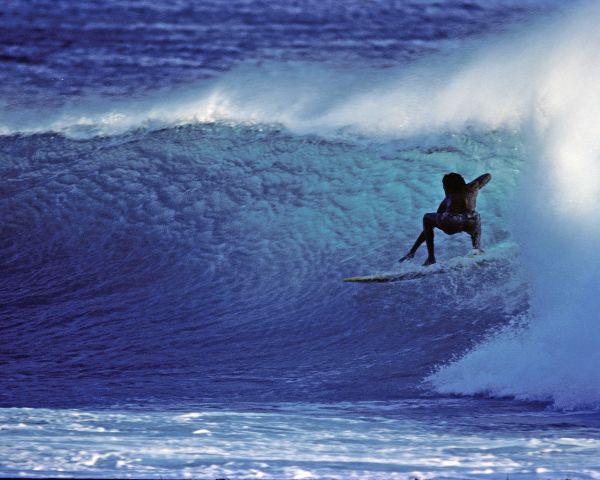
Photograph by Larry Goddard.
Not for commercial use.
Appendix
A. First experience with paipos.
I
was a draftsman for a while after I finished college, working for
Douglas Aircraft Company. Then I spent 3 years in the Army (Radio
Repair and Communications) with 2 years in Germany. After I was
discharged in 1961, I couldn't wait to get back to my first love:
Bodysurfing. But, that was two years after the movie "Gidget" came out,
and now the waves were crowded in Southern California's "South Bay"
(Los Angeles area) where I used to surf nearly alone. Oh man! What a
bummer...
I bodysurfed and rode one of 3 surfboards through all of 1962, '63 and
most of '64. I met a kneerider in Huntington Beach (who was already in
his mid-40s, and owned a VW dealership in town) in the summer of '64,
and he introduced me to a really FUN new way to ride waves. A good
kneeboard rider could run circles around the longboard riders...it was
like a Porsche surrounded by a bunch of 18-wheelers!
At the end of summer of '64, I went to Hermosa Beach's "Pier Avenue
School" one Friday evening to see a surf movie (16 millimeter) that
showed Waimea Bay at 20 feet. One scene showed Greg Noll dropping in on
a big one, making his turn on a precariously steep wave and beginning
his run across the two-story face. Then the camera stopped panning and
following Greg, then backed up to the right and up to the lip of the
wave pitching out 15-20 yards behind Greg, where a guy laying down on
something called a "Paipo Board" was free-falling down the vertical
face of the wave. When he hit the wave face he skipped like a flat
skipping stone, and then skipped again as he made his turn. Seconds
later, the paipo rider went flying past Greg Noll like a rocket ship!
Oh...My...Gawd!! Everybody in the audience let out a gasp: Wow! WHAT
was THAT guy riding?
The next morning, at 10AM, I was waiting outside Greg Noll's surf shop
on Pacific Coast Highway, caddy-corner across the wide intersection
from the school where the film showed the night before. When Greg
opened the doors of the shop, I told him about the movie I had seen the
night before, asking him about the Paipo Board that passed him on the
big wave. He told me it was a small, flat-bottomed plywood board,
without any skegs, and probably was faster than ANY surfboard, even his
big gun. AND he just happened to have 3 of them that Val Valentine had
sent him from Hawaii. They were designed by the same guy that passed
him at Waimea Bay that day. A guy named "John Waidelich".
So, I bought one of the first 3 "Paipo Nui" sold in California (Greg
said it was his first shipment from Val). I rode it from San Diego to
Point Dume, in waves from 3 feet up to 12 ft plus. It was a BLAST on
big point break waves! But, I lost it once on a late takeoff at Lunada
Bay in 12 ft surf (that was OUR "Waimea" spot), and the board got
destroyed on the rocks. That was in the winter of '64-'65. I heard
about Bob Crabb's "Ventral Vindicator" and drove down past Huntington
Beach to buy one. It lasted til I started making my own boards out of
foam and fiberglass late in '65. I gave it to a high school kid I knew.
B.
Shaping his own boards.
I
started riding a Paipo Nui in about 1964, but then began designing
foam-and-fiberglass bellyboards and having surf shops (Bing Copeland,
Gordon & Smith) shape them for me. Then, in 1965, after watching
several boards get shaped, but not quite the way I had in mind, I began
shaping them myself. I studied the bottoms of Hydroplane racing boats
and Dragboats (at Long Beach Marine Stadium, where a young Eddie Hill
was going FAST), and talked to hull designers at every opportunity,
learning about hydrodynamics.
C.
Contact with George Greenough.
The
first time I took my fastest bellyboard (concave bottom, low, hard
rails) to Rincon, I met George Greenough, and we had some interesting
discussions about board design, and high-performance surfing. He felt,
like me, that 'hanging ten' and otherwise 'posing' on a long board
going in a straight line was not the way to really RIDE a wave.
Boooring!
George had a 13" plexiglass skeg on his spoon kneeboard, that he
patterned after the tailfin of a Bluefin Tuna. WOW! Nature had taken
millions of years of 'Research and Development' to perfect a fin
design. But, Surfboards had big square un-foiled monstrosities set too
far back near the tailblock (Greg Noll, Weber, etc). You needed
power-steering to turn the board! That's alright, the board didn't
need to turn much; it was only a moving stage or platform for the
'poseur' to do his routine. The board didn't DO ANYTHING. The rider
went through his various poses (El Spontaneo, Quasimodo, etc, named by
Micky Munoz) as gracefully as possible. That was considered "hot dog'
surfing. Ha!
D.
On leaving California.
When
the L.A. smog got so bad I couldn't breathe anymore, and the ocean
water along the beaches of the South Bay (in Southern California) was
getting more polluted from the off-shore oil-drilling platforms, I
finally said "Enough, already!" and started making plans to move
elsewhere. I even considered Australia!
After the January '69 Santa Barbara oil spill, that was the 'last
straw' for me! I decided to move to Hawaii. It took me 'til September
'69 to finally sell off everything (state-of-the-art stereo system, '32
Ford street roadster, and a '65 Corvette Stingray, and my gun
collection).
I came to Hawaii to pursue board design, and got to know most of the
surfboard shapers on Oahu. I shared a house on the North Shore with
Midget Farrelly and his wife and baby girl, during the winter surf
season of 1970-71. I met him thru' a mutual friend, Leroy Grannis, a
surf photographer then living in Hermosa Beach. Farrelly had a 5-ft
"Hayden" Greenough Spoon that I watched him ride at Ehukai and Gas
Chambers. He was also a great surfer standing up on a surfboard (winner
of the 1962 Makaha International, and in 1964, the Australian National
Titles and the 1st World Surfing Championship). After that, I lived on
the "West Side", i.e., the Waianae Coast, at Makaha Surfing Beach.
While there, I spent 16 years fine-tuning my bellyboard (foam and
fiberglass Paipo) designs and building a few kneeboards as well.
E.
Design ideas?
After
watching 3 guys shape bellyboards for me, that I sketched out the shape
for, and having them put their own rail and bottom shapes on the blank,
I figured 'that doesn't look so difficult...maybe I could shape one
myself, and get it to look the way I WANTED'.
In 1964, all I had was a bunch of sketches of my ideas. But, in 1965, I
had to make my OWN templates, so I started using my old draftsman’s
tools (French Curves, mostly) to lay out the scale drawings, then I
learned how to make full-scale templates from the drawings. I started
out by drawing a series of possible nose shapes, then tail shapes, then
top and bottom curves to get the desired 'Thickness Flow' for
bellyboards and kneeboards.
For any given board width, I could use numerous different nose widths
and tail widths. And the nose SHAPES could also vary from pointy,
(which I detest on a bellyboard, but looks OK on kneeboards), to
rounded noses. Also, different tail shapes could be applied to each
given board width, from rounded to diamond to crescent to elliptical
and exponential and squared, with various amounts of rounding at the
corners.
The permutations of possible shapes are many, and I ended up with
several hundred possibilities. I realized that if I could manage to
build a new board EVERY week, (say 50 boards a year), that I wouldn't
LIVE long enough to build all the theoretically possible different
boards. I picked out the combinations that 'looked' right to my eyes.
Aircraft engineers of old (before the days of supersonic flight) knew
that if it looked 'right', it probably would fly pretty nicely. You
could put an engine on a BOX KITE and make it fly! But it would be
UGLY! It's not an accident that the British Spitfire and the American
P-51 are GREAT aircraft: they are beautiful
designs...artistic...pleasing to the eye...and created from
Mathematical Curves! That was my "Aha!" moment, when I discovered the
secret.
Many years later, when I met Dick Brewer, I discovered that HE also had
used mathematical curves (and ship-builder's French Curves in
particular) back in the '50s and '60s to design his beautiful 'Island
Boards' for the powerful North Shore surf. The boards 'looked right',
and worked famously well in big surf. Why am I not surprised?
I only built maybe 40 or 50 out of 400-500 possible shapes, and most of
the ones that looked right also worked well. I barely scratched the
surface of 'possibilities'...
Once I found a good shape, I could scale that design up or down to fit
the size of the individual surfer. I made boards for kids that would
feel the same to them as the bigger version would to the big
250-300-pound local guy. Same SHAPE design in each case, but endless
variations of each would be possible. Mind boggling, yeah?
"Makaha
Missile" series high-speed point break bellyboards. Shaped in 1970,
Larry still has the 18" wide model - it is 39 years old now (second
from the left).
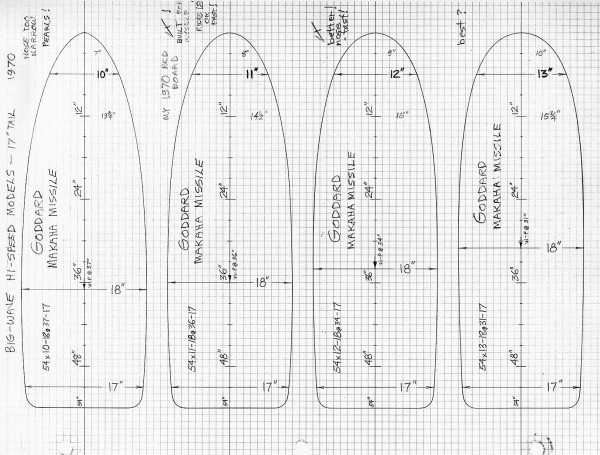
Drawings & scans by Larry Goddard (see more design sheets here).
F.
The Makaha missile series.
My
best board at Makaha was 54"x22", 2 1/2" thick, and had a 19"-wide
tail, with a wide round nose. It was VERY fast because of the shallow
concave bottom and low, hard rails. It worked so well even in
medium-large Point Break (15 ft or so), that I only used the "MAKAHA
MISSILE" in 18-20 ft surf, and on the North Shore from 8-18 ft. At 20
ft, I would either go at Waimea, or more likely, just stay at
Makaha...my favorite break of all. I LOVE long fast point break waves!
I made them in widths of 18", 19", and 20". The narrowest one was
difficult to stay on when bouncing at high speed across lumpy waves, so
I limited my big-wave surfing to the glassy days! On a skegless wooden
paipo, with a 30" wide tail, you had more side-to-side leeway in where
your body had to be positioned and still be able to maintain control.
But that wide tail with no skeg was hard to turn unless you pulled the
board up high on a rail like banking an airplane. Ever seen a bird with
a rudder? Not needed... They turn by steeply banking. Simple!
The 'Missile' boards all shared the same 'Exponential-Curve' outline
for high-speed on point breaks. Not the easiest to turn at speed, but
VERY fast on flat-out "Pedal-to-the- Metal" planing moments. I know YOU
can appreciate the feeling of going 40 MPH on a long BIG point break
wave! It is a visual treat, too, because we paipo riders have our eyes
so close to the water, the sensation of SPEED is magnified
significantly over what a stand-up surfer experiences! Talk about
adrenaline junkies! Man!, what a rush!
For my hot dog board designs, I used a more rounded 'Elliptical Curve'
outline, with more rounded corners in the tail. The high-speed boards
had small-radius rounded corners on an otherwise square tail. That was
to maintain as much planing area as possible
at the rear of the board.
Nearly all my boards had either concave bottoms or flat bottoms, with
the straight planing area on the bottom beginning about 18" from the
nose. |

Larry Goddard and John Clark and the Makaha Missile at Waikiki Beach,
Dec. 2009.
Photo by: Bud
Scelsa |
The nose kick I used in the '60s was about 3 inches, but I reduced it
to 2 1/2 inches in the '70s, and to only 2 inches in the '80s using a
flatter 'Hyperbolic Curve' instead of a portion of an Exponential Curve
that everybody else uses even today. Remember Reno Abellira's
exaggerated 'snow-ski' nose kick that he used on his surfboards in the
early '70s? It was an attention-attracting personal 'statement' or
trademark design. But it was worthless as a lift-producing design
element. All it did was create lots of drag if the nose started to
pearl below the surface of the water. No good...
The easiest-turning high speed board I ever made had a soft-vee bottom
in the nose area AND another Soft Vee in the tail. All I had to do was
lean to the side, and the board turned without any effort, all by
itself. I could ride with BOTH arms extended forward in the
air...riding hands off! Showing off! Ha! I let a guy at Makaha talk me
out of it, so I only rode it a few times in point break.
Makaha Missile
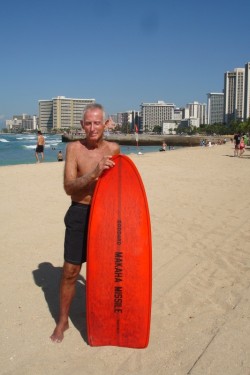 |
|
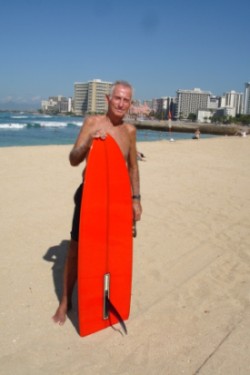 |
|
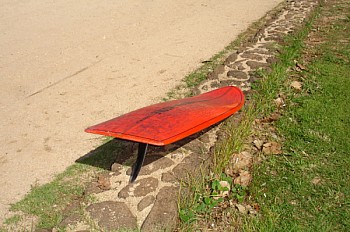 |
|
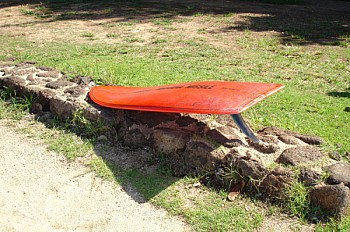 |
|
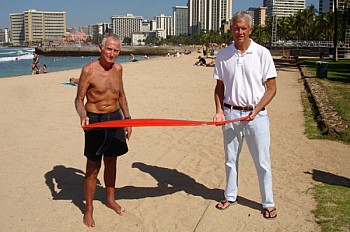 |
|
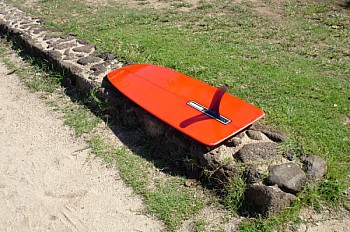 |
|
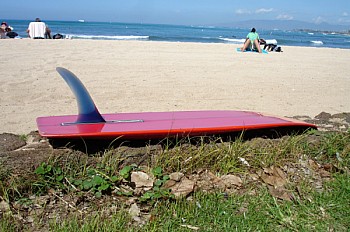 |
|
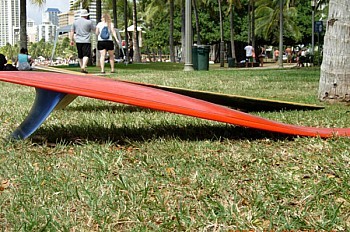
|
Larry
comments, "This is a side view of my Big wave board, the super-thin (in
the nose) 18" wide MAKAHA MISSILE. It handles 20 ft surf as long as the
water is smooth. Probably too narrow, tho', at only 18 inches."
|
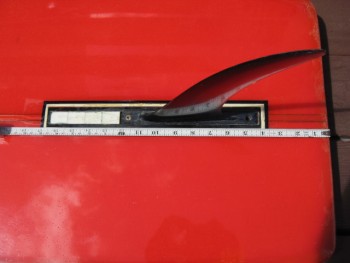
|
|
Close
up view of the Makaha Missile's 9-inch 'Fins Unlimited' refoiled skeg
in the same-make fin box, with a tape measure alongside for showing the
position of the fin. |
|
Shown here is diagram 19-BDS from the design sheets. See
more Makaha Missile diagrams: 11-BDS, 12-BDS, and the top drawing on
14-BDS.
Pictured
here is the shorter 51-inch version of the original 54-inch "Maili
Marauder." I
thought it would make a decent hot dog board for the Inside Makaha
Rights. It is NOT a Makaha Missile! It was intended for the 4-8 ft surf
in the inside and middle lineups on NW to North Swells at Makaha, not
Point Break (12'+). And I even made a few of these boards only 48"
long, for short but husky local guys (see diagrams 23-26 BDS in the design sheets). Too
short for my
taste, but for a 'pocket rocket', they worked just fine. Diagram #26
BDS was
the best one!
|
|
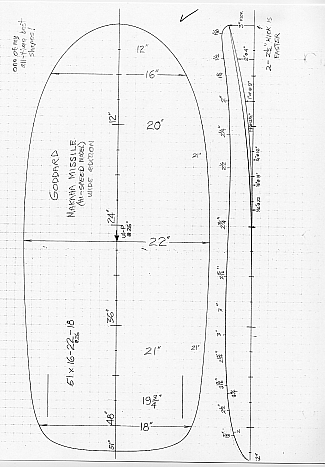
|
Photos by: Bud
Scelsa, except for the Makaha Missile Fins Unlimited figure at the
bottom by Larry Goddard. Design
sheet by: Larry Goddard.
G.
Fins on paipo.
I
rode single-skeg bellyboards mostly in the late '60s, in Southern
California, and down into Baja. But, after I moved to Hawaii to design
and test my board designs, I discovered I liked the more precise
control I could get from Twin Fins, especially at Makaha, where the
waves are so much juicier! There are more opportunities there on good
days for performing 'Round-House-Cutbacks'...my specialty and favorite
manoeuvre in the '70s. The wide tails I put on my boards meant I could
often pull a single fin ALL the way out of the water on a really hard
turn. But, then the board got too 'loose' and squirrelly for my taste. I
prefer the 'riding on railroad tracks' feeling of exact control.
If you are riding a 'sponge' or a skegless plyboard paipo, you are used
to the "Loose as a Goose" ride! I raced a little bit of "Roundy-Round"
(Circle-Track) dirt-track (jalopies) in my high schooldays, and that
was really fun, but later I got more 'into' Sports Cars and loved THAT
kind of handling on a race track. Before I came to Hawaii, I also raced
Go-Karts, and that involves a fair bit of sliding in the turns...On
Purpose!
My all-around board, 39 years
old this past summer, is the "Twin Fin
Hustler." The
board is 51" long by 21"
wide and 2"
thick at 1 to 2 feet from the tail. (It was made on the thin side for
ease in ducking under waves. Most of my boards in the 1970 time period
were 2 1/2" thick.) Made
for point break surf, great from 6-12 ft. It's
pretty fast!! But
my big-wave board is a single skeg (two fins can get you in trouble in
15-20 ft surf!). My new
board (the extra-thick yellow one) is a
single-skeg board for now, but I might add a couple fin boxes to it so
I can switch configurations for different kinds of surf.
|
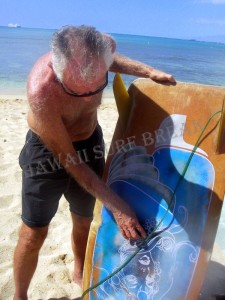
Larry's 39 year old
"Twin Fin Hustler" (51" x 21" x 2")
Photo
by: Christina Rainwater. |
The
"Twin Fin Hustler"
|
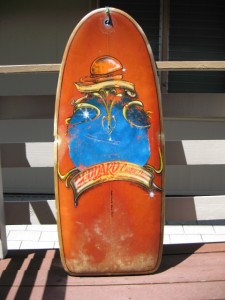
|
|
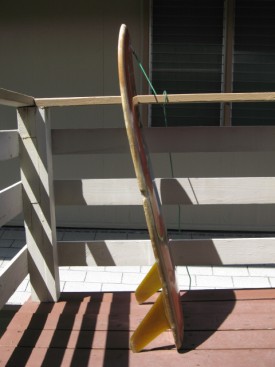
|
|
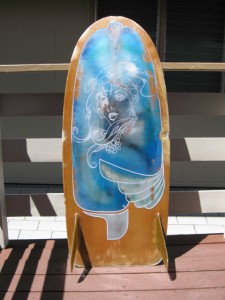
|
|
| The
board at the top of the figure is my June, 1970-built "Twin-Fin
Hustler," the 51" long by 21" wide version. The nose is reported in the
model designation on the drawing as "18 1/2 inches," but that was the
width of the nose measured at 12" back. All my nose widths since then
are given as the width at 6" back, (15" on the Hustler), while the
'shoulder width is measured at 12" back. To more completely describe a
nose shape, I would include the width at 3" back, so that the nose
shape would therefore be described as 11 1/4" - 15" - 18 1/2" in the
case of the Hustler. |
|
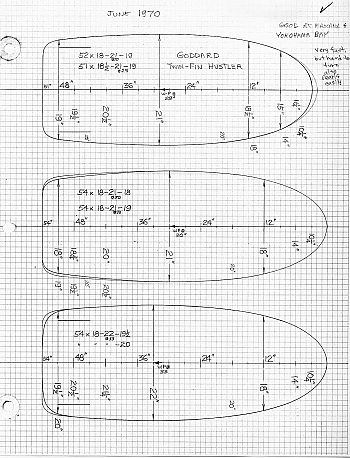
|
Photos
and design sheet by: Larry Goddard. |
|
For high
speed, "pedal-to-the-metal" kine surfing, tho' I prefer a single skeg
for minimal drag. Twin fins can only be 'tuned' (toed in) for one
speed...the rest of the time, they are fighting each other.
Larry Goddard shaped his new
board at
Harry Akisada's house in early June 2008.
The board was at the glasser's shop when he broke his arm at Cunhas a
week later. It wasn't until the end of September when I rode it for the
first time (at Cunhas, in 5 ft surf), 3 1/2 months after I broke my
arm. It was my first time back in the surf! The doctor at Tripler
Hospital told me it would be 6-8 months before I could even THINK about
surfing again. Ha!
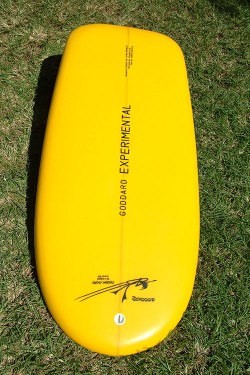
|
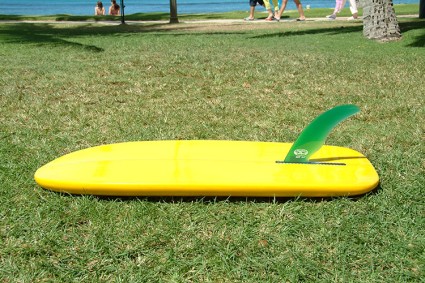
The "Goddard Experimental" is 51 inches long,
23 inches wide and an extra
thick 3 inches. This board is made for
small waves up to 7-8
ft, or thick, high tide waves when I need more glide across the dead
spots. It's a single fin, concave bottom, hard-rail design. I
shaped it with a concave bottom and
VERY hard rails. It really flies! I can pass up anything BUT a wide
skegless plyboard paipo. Corvettes can't pass Ferraris on the open road!
|
|
This
is my latest version of the 1976 Maili Marauder 51" version, but not
the hot-dog tail version, rather the Extra-Wide-Tail version that I
designed back in 1987, and called the "Ultra-High Speed Model." Instead
of twin fins, I returned to the single-fin design of the very fast 54"
Maili Marauder that I made for Stan Wright in 1972 (the orange board,
seen in the interview photos). Because of the super-hard rails, thick
nose, and the nose-to-tail concave bottom, I named my new yellow board
simply the "Experimental" model. I now call it "Mellow Yellow" after
the famous song. I get a Natural High when I ride it. It's my magic
flying carpet! (I've never experimented with drugs... didn't need an
artificial chemical high, because surfing, snorkeling, and flying
airplanes gave me a John-Denver style natural high.)
|
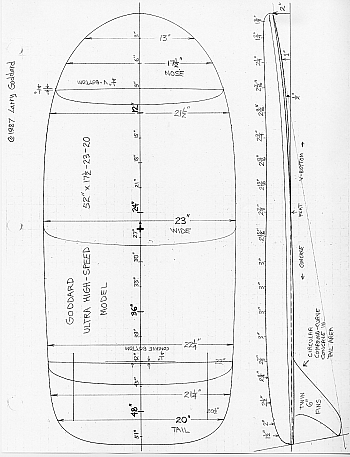
|
Photos and design sheet by: Larry Goddard. |
H.
Board length.
I'll
try to measure the thickness of Harry Akisada's old 1980s paipo board
next time I stop in at the surf shop where it is now. It is made of
Poplar wood, and I think it has one layer of fiberglass cloth on it.
The beautiful figure of the wood is clearly visible. Harry made it with
a length equal to 2/3rds of his height, about the ratio I used on my
early (1960s) foam 'n fiberglass bellyboards. But for long, fast point
breaks, I found I could benefit by going longer for more flat planing
area, (for higher speed), with the maximum length set at about 3/4ths
of my height. (That's about 54" for a guy 6 ft tall; and 51" for a guy
5' 8" tall.)
Harry
Akisada, two-time Makapu'u Paipo Champion, who makes the most
sophisticated double-concave skegless paipos on this planet! He is a
regular at Makaha, Makapu'u, Walls, Publics, and Cunhas.
|
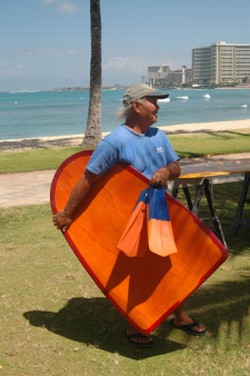
|
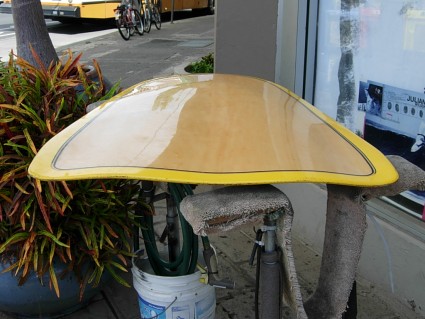
Pictured
above is one of Harry's old boards, built in 1978, on the stand outside
the entrance to the "Aloha Board Shop" at King Street and University
Ave. in Honolulu.
|
| Harry
is a master paipo designer/builder. He still rides anything from 3 to
12 foot plus and is a regular out at Makaha, where he's been surfing
for well over 40 years now. |
Photos by: Larry
Goddard. |
For a more 'all-around board' length, I settled on a 'board
length'-to-'surfer height' ratio of about 0.707 to 1, (or about the
square root of 0.5). That works out to around 48" for a 68" tall guy,
and about 51" for the 6 ft rider. Round-nose skegless plyboard paipos
should only be about 2/3rds of the rider's height, or they get a little
hard to handle, in my opinion.
Not sure about the best 'aspect ratio' of a wood paipo, but it seems
that a width of about .66 times the length is what Harry used on his
Poplar board.
The narrowest boards I made, usually for big or juicy waves, were no
less than 0.25 times my height, and the widest boards I ever made (for
thick, high tide waves) were never more than 1/3 of my height. But, for
all-around boards, I found 0.30 to 0.32 times my height to be pretty
easy to handle for the most typical waves at Makaha. I like wider
boards for the softer-breaking waves in Waikiki, tho', (1/3rd my
height).
The longest board anybody ever made for me was 56 1/4 inches, shaped by
Floyd Smith (of Gordon & Smith, in early 1965), following my
sketches of what I thought would make a combination Knee/Belly Board.
It proved to be too long for belly riding, and a little too short for
kneeriding. Jack of all trades, but Master of none!
The problem with boards that are much longer than about 70-75% of your
height is that you are forced to slide several inches forward to trim
properly on a long, fast section, then you have to slide WAY back to
get set up for a hard cutback. My favorite maneuver at Rincon Point and
at Makaha Beach is a big, radical Round-house Cutback, throwing up
spray like a waterskier. That's with the board banked quite steeply,
maybe 50-60 degrees, carving around with only the rail still in the
water. Exhilarating! I learned that from watching George Greenough at
Rincon on 10-12 ft days (600 yard rights). I started shaping my own
boards after that Floyd Smith board proved to be too long for my style
of riding. I DO like to go fast, tho'...that's why all my boards have
concave bottoms and hard rails. But I prefer more flotation for ease in
catching fast-moving, well-overhead waves.
I.
Crowds.
I
don't like crowds much, but no matter where you go, the good waves are
all so crowded nowadays. So we have to just go out very early (first
light at Makaha for me!), or plan on catching the best tide or the peak
of the swell (calculated beforehand by what the buoys a couple hundred
miles away were reporting). There must still be a few undiscovered surf
spots on this planet.
J.
More on designs and design sheets.
As
a one-time draftsman, I had the tools and the ability to create a wide
range of possible bellyboard designs as scale drawings on graph paper.
These outline exercises were drawn to see what a variety of different
nose and tail shapes would look like for any given board width.
I tried board lengths at 1 inch intervals, mostly from 45" to 54"
inclusive, (10 different widths), and applied 5 different nose widths
and 5 different tail widths to each board width. Total possible shapes
= 1,250. The board lengths that worked best for my surfing ranged from
a shortest of 2/3rds my height to a longest that was 3/4ths of my
height (72" or 6' 0" in the late '60s to late '70s). That was 48" to
54" for a 6-ft tall surfer. To scale these board lengths down for a guy
who's 60" (or 5' 0") tall, the shortest board for him would then be 40"
long, and the longest board would be 45". But, I only made board
designs down to 42" for a very few people (= kinda short for a guy 63"
tall; kinda long for a 56" (4' 8") kid).
The longer boards are needed for high speed planing in 'freight-train'
waves, and fast point breaks. The shorter boards are easier to handle
and maneuver in hot-dogging waves, and beach breaks. For a comfortable
average, the board length should be around 70% to 71% of the rider's
height.
The board widths should be no narrower than about 1/4th of the rider's
height, and no more than about 1/3rd of their height. For a 6 ft tall
surfer, that would be 18" (for big fast waves), to 24" (for small,
thick waves, or at high tide). The narrow board is hard to stay on when
riding bumpy, lumpy waves at high speed. And the widest boards require
more effort when going into a cutback. You have to power it into a
steep bank, in order to get a radical round-house cutback going. But,
it is oh, so nice! gliding across the flat spots in the wave. It's less
likely to bog down or stall when going across the dead spots. Ask the
skegless paipo riders! I recommend a board width for most wave
conditions of about 30% of the rider's height.
Surfboard designers measure the nose width 12" back from the nose,
which may be very pointy. But, since a pointed nose on a short
bellyboard is useless and non-functional, I use a round-nose design,
and measure the nose width at 6 " back from the tip of the nose. Then,
the 'shoulders' would be measured at a point 12" back from the nose. I
thought that the nose widths looked best when they were about 60% to
80% of the board's maximum width, and a nice compromise is about 70% of
the width.
For bellyboards that will be used in hotdog waves, the tail widths will
be narrower than for a board that needs to go fast. The width of wide
tails with rounded square corners is best measured at a point only 3"
from the tail of the board. I used 75% of the board width for the
hot-dog boards, and 90% for the high-speed designs. Then, the 'hips'
can be measured at 12" up from the tail end of the board.
The outline shape of the hotdog boards is elliptical, and for the
high-speed boards, I use an 'Exponential Curve" which gets straighter
towards the rear half of the board.
If I drew boards from 42" to 57" long for people 4' 8" to 6' 4" tall,
that would be 16 different board lengths, with 5 possible nose widths
and 5 possible tail widths for each of 5 possible board widths, giving
a total of 16 x 5 x 5 x 5 = 2,000 different possible shapes! There were
many combinations that obviously didn't look like they'd work, so I
whittled the list of possibilities down to only 400, and in the 20
years that I was making custom boards, only about 40 of the possible
shapes were ever actually made and ridden. Half of them were pretty
good, (in Hawaiian surf, at least). Ha! ONE good board design a year!
I have two notebooks full of scale drawings of bellyboard and kneeboard
designs, 90% of which never even got built. I only built the ones that
looked the most promising, based on my previous experience with earlier
shapes. Out of maybe 400 possibilities, I only actually built about 40.
Makes you wonder if there are any 'gems in the rough' lurking among the
untried designs... Hmmm...Oh well... Below is a sampling of my design
sheets.
Drawings & scans by Larry Goddard. See more
design sheets here.
Maili Marauder Prototype. These
pictures are of a
board made for a friend, Stan Wright, back in 1972. It was designed for
big, thick, freight-train point break waves. The first time we went
out in big Maili Point surf, it was a perfect, glassy 10 ft (double
overhead) day, with 1/2-mile rides! Stan on his new board just ran away
from me on the first wave we both caught together. That was when I knew
I had a real winner! The board is 54" x 22" x 3", and had an 18" wide
tail (measured 3" from the tail), with a single 10" skeg. My friend is
a husky Texan who was in the Navy here in Hawaii. He still has the
board and took the pictures for me just last week (April 2010).
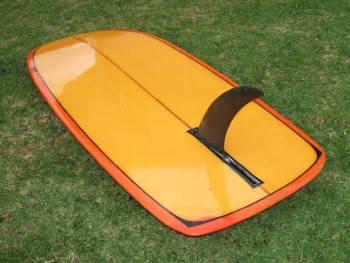
|
|
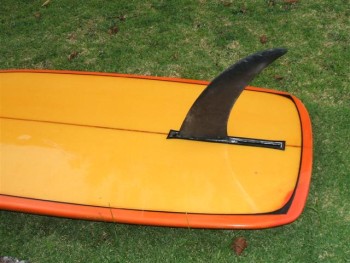
|
|
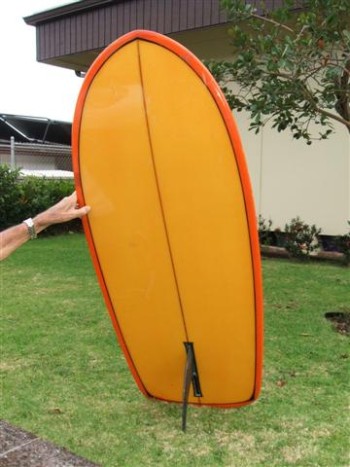
|
|
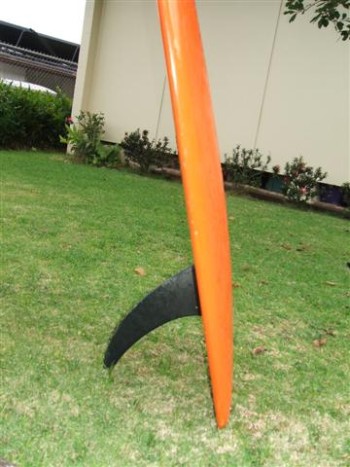
|
|
| This
was the second, but shorter 51" hot-dog version of the 1972 "Maili
Marauder," made in 1976, for a short but very husky guy named "Frosty
the Snowman," who was a rock musician with Lee Michaels, living for a
while in Makaha. They moved back to San Francisco before the board was
finished, so he never got to ride it. It turned out to be the best
board I ever made for South Shore (Waikiki) surf, and I rode it until
it got stolen in 1985, from a friend of mine's house in Honolulu. My
new yellow board is a wider-tailed version of this board. Super-fast! |
|
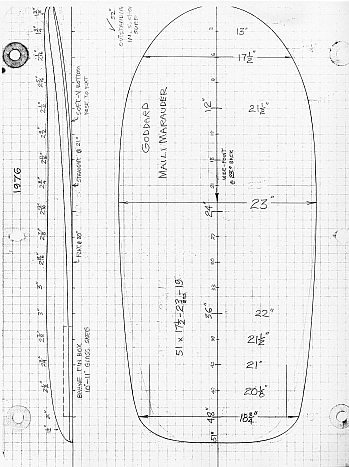
|
Photos and design sheet by: Larry Goddard. |
K.
The paipo guys at Queens Beach in front of Kapiolani Park (near the
Honolulu Zoo).
The
paipo riders that hang out here at Queens Beach are the largest group
of paipo board surfers on Oahu, and probably in all of Hawaii? Great
bunch of guys!
|
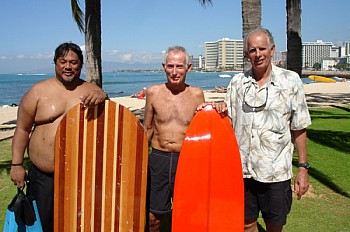
Above: Kimo Kealoha, Larry Goddard, and Bud
Scelsa,at Queens Beach in front of Kapiolani Park, Honolulu.
Right: Kimo
Kealoha
with
one of Bud Scelsa's signature design paipo boards. Bud likes to
laminate, in this case, redwood and pine, and always puts a four-strip
tailblock on the bottom of his boards. This board is 53 inches long, 25
inches wide, and fiberglassed.
Photo
above and right by: John Clark.
|
|
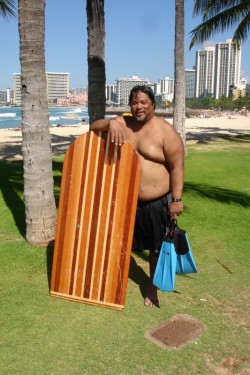 |
|
The
paipo guys at Queens Beach in front of Kapiolani Park (near the
Honolulu Zoo). They're down there every weekend or whenever there's
surf.
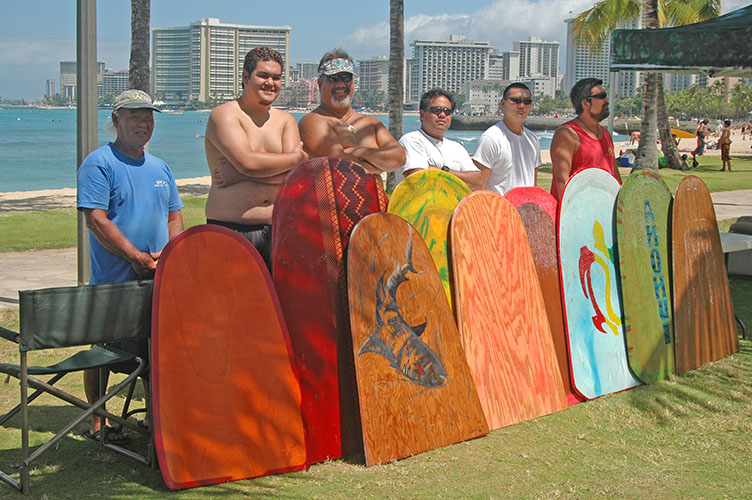
Pictured from left to right are: Harry Akisada, "Pono Ed" (?...not
sure), "Big ED" Earmore, John Namaka Jr., Steven Hong, and his dad, Nate Hong. Not
present were several other regulars who weren't there that day.
Photo by: Larry
Goddard. |
|
Addendum to original interview -- Q&A
in the Swaylock's Surfboard Design
Forum.
L.
An answer in response to a question by krusher4, asking if Larry was
around when Tom Morey's first boogie boards came out, did he try riding
one and what he thought of the boogie board.
Hi, guys!
I probably rode the one of the first Morey Boogie Boards in Hawaii, or
at least the first one in Honolulu. I don't know if anybody took it out
before I tried it out at Ala Moana Bowls, but one summer day in the
mid-'70s, I got a call from a friend, Rich Parr, who had a surf shop on
South Street in Town. He said that 'a friend of mine' had left
something at the shop and wanted me to drive down from Makaha and check
it out.
After a long drive to Town, when I got to the surf shop, Tom Morey had
already left, but Rich showed me the soft, flexible 'bellyboard' that
Tom had named the 'Boogie' board because you could really boogie on the
wave with it, without fear of getting beat up by a hard board if you got
wiped out. You were free to get really crazy with it, without any
restraint or hesitation.
Well, I went out in the overhead surf at Bowls, and without a skeg, I
just tail-slid on the takeoff and sort of spun out, and ended up going
down to the bottom of the steep wave BACKWARDS! That was SO
uncool...very embarrassing! I tried again, and AGAIN, until I finally
managed to get one ride without anybody dropping in on me.
I felt the soft board 'snaking' over the lumps and larger bumps from
the wind chop. My first impression was that the board was TOO soft and
WAY too loose, and couldn't get up to speed because of the uneven
bottom curvature due to excessive flex. I was used to a flat or
shallow-concave bottom 'planing hull' of my Makaha boards. I suggested
to some people that maybe the soft boards would be better if they were
a little stiffer and a lot smoother on the bottom, i.e., ...like a
bellyboard.
If I had had a chance to talk to Tom before I went out with that board,
he would have explained to me that you need to 'set the rail' to gain
control on the steep takeoffs. You also need to hold the board
differently: one arm across the nose and one arm alongside the board.
Oh well...
The kind of people who were buying the Boogie Board kits during the
first couple years were relatively inexperienced in the water, often
just beginners riding straight in toward the beach in the white water,
thereby cutting off the stand-up surfers who were properly angling
across the wave. And the result in many popular surf spots was
conflicts and even fights in the water. At some places, like Malibu,
boogieboards were banned!
When the first 'improved' bodyboards were made available (Turbo,
notably, in Honolulu), with a smooth skin and a stiffened shape, some
guys who were experienced bodysurfers or paipo riders started giving
them a try. They even went out in better waves...like the experts-only
Banzai Pipeline. Then they started doing crazy things that surfers
could only DREAM about: barrel rolls, big air, spinners, etc. After
that, it quickly became 'all right' to be a 'sponge rider'!
Who, besides Tom Morey, would've ever thought that some day
bodyboarders would outnumber surfboard riders, worldwide? Amazing
foresight from a creative guy thinking 'out of the box'. George
Greenough was another visionary, who thought surfers would have more
fun on a wave if they were on a shorter board and could utilize the
WHOLE wave, instead of just 'posing' on a moving platform, hangin' ten!
That was the beginning of the modern shortboard era, and the way we all
want to surf now!
But..., now there are TOO many people in every lineup! We need more
artificial reefs and wave machines. What will surfing be like in 25
years...50 years...100 years (IF any of the survivors of the 3rd World
War have time for such frivolous pursuits!). We should all consider
ourselves lucky that we can still do this thing called 'Surfing'. Ha!
LarryG
Source: Goddard,
Larry. (2012, November 13). Need input on belly board design. Swaylock's
Surfboard Design Forum. Retrieved November 13, 2012, from www2.swaylocks.com/forums/need-input-belly-board-design?page=9#comment-1472880
|


























